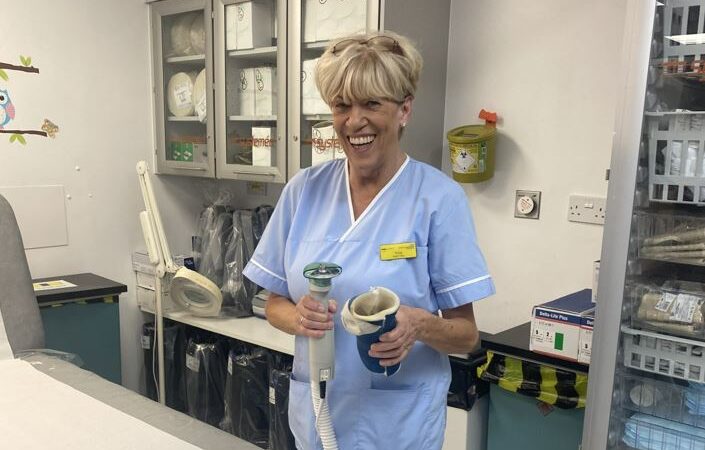
Trish Grigg has had a 28 year career with UHSussex, working as an Orthopaedic technician at St Richards, and Worthing.
Over her time at the Trust Trish reckons she’s been tending to the broken bones of around 40 patients a day.
“It used to be about 50,” she pondered. “But over the years it’s gone down to 30, so on average over my career here, probably around 40 a day.”
So with a rough calculation that’s nowhere near as precise as her plastering, Trish has seen an estimated 257,000 patients*.
Which, give or take the odd femur or fibula, metatarsal or metacarpal, is about the population of Brighton!*
And that’s a lot of people needing fixing.
It all started for Trish when her manager on an orthopaedic ward asked her: “Would you like to learn how to plaster?”
Trish takes up the story.
“I said ‘yes,’ and they brought me down and I absolutely loved it. But I had no idea what I had to learn. No idea at all.
“You go right back to the basics: how the body is formed, what bones are made up of, the in’s and out’s of blood supply.
“There’s 206 bones in the body and you have to know them all. And we plaster every one of them apart from those on the face.”
Trish does indeed know them all, and there’s not many of them that she hasn’t plastered.
“Over the years I’ve done so many. It used to be about 50 a day but as technology has improved, you don’t need to plaster all the time for injuries, so it went down to 30.
“I’ve done jackets. I’ve done jackets for scoliosis. I’ve done frog plasters for children with dysplasia hip, fibula’s, femurs, everything.”
Trish has slowed down a bit now, and works part-time, spending time with her daughter, Jodie, and her granddaughter, Lilly.
That’s part of the reason her team is looking for a trainee technician to join the team in Worthing, who will be trained up by Trish.
“We have teams across all our sites and we are looking for someone who will join us at Worthing – and we will teach them.
“We teach them first hand. We stick to layman’s terms to begin with as the terminology on its own is quite intense. And the programme is too, with them learning to plaster as well.
“Of course, they have to learn all the medial terms for the exam. Within two years they are fully trained and ready to go and have a great career doing a great job.”
Every broken bone has a story behind it. So, what’s the most bizarre one that comes to mind for Trish?
“I don’t think anything can beat this: a female patient had a wish list and she wanted to have a ride in a hot air balloon. Due to the weather the balloon came down, and she came out backwards out of it and broke both her femurs and a load of ribs.
“So painful. Before that incident I had always thought, ‘I would like to go in a hot air balloon. But that put me right off. You know, I really thought, ‘no, that’s not for me.’
So, hot air balloon rides are not for Trish. But being an orthopaedic technician certainly has been, and it could be for someone else at UHSussex, to get the first steps on the ladder and have a career as rewarding as the one Trish still enjoys.
*taking 40 patients a day, 46 weeks a year (six weeks off for leave), for 28 years, works out at 257,600
*population of Brighton is est 271,000